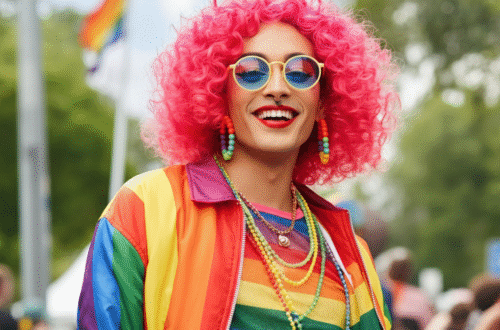Visual kei is a vibrant and theatrical movement that has captivated audiences for decades. It’s more than just a music genre; it’s a full-blown subculture where fashion is as crucial as the sound. At its heart, visual kei fashion is about breaking rules, embracing androgyny, and creating a unique identity that is both shocking and beautiful. This style is a form of self-expression that blurs the lines between costume and clothing, turning every artist into a living piece of art.
Originating in Japan in the 1980s, visual kei (literally “visual style”) was pioneered by bands who wanted their appearance to be as dramatic and impactful as their music. This guide will walk you through the elaborate world of visual kei fashion, from its historical roots to its modern interpretations. We will explore the key elements, iconic sub-styles, and the enduring legacy of this influential Japanese fashion movement.
Key Takeaways
- Visual kei fashion is an integral part of the visual kei music movement, emphasizing androgyny, elaborate hairstyles, and dramatic makeup.
- The style emerged in the 1980s, heavily influenced by Western glam rock, goth, and punk, but with a uniquely Japanese twist.
- Key elements include dark and theatrical clothing, bold and colorful hair, heavy makeup, and a wide array of accessories.
- Over the decades, visual kei has evolved into various sub-styles, each with its distinct aesthetic, from the elegant to the grotesque.
- The influence of visual kei extends beyond music, impacting global fashion, anime, and pop culture.
The Origins of a Visual Revolution
The story of visual kei fashion begins in the 1980s Japanese music scene. During this period, a new wave of bands began to challenge the mainstream. They were tired of conforming to simple, clean-cut images and instead looked to Western movements like glam rock, punk, and gothic rock for inspiration. Artists like David Bowie, Kiss, and the New York Dolls showed that a powerful stage presence involved a striking visual identity.
Japanese bands took these influences and created something entirely new. The legendary band X Japan is often credited as one of the pioneers of the movement. Their motto, “Psychedelic Violence Crime of Visual Shock,” gave the genre its name. Their look was a collision of styles: towering, spiked hair, intricate leather outfits, and dramatic makeup that was both masculine and feminine. They set the stage for what visual kei fashion would become—a celebration of individuality and artistic freedom. This wasn’t just about looking different; it was a statement against the conservative norms of Japanese society, a way to express rebellion and creativity visually.
Core Elements of Visual Kei Fashion
While visual kei is incredibly diverse, several core components define the overall aesthetic. These elements are combined in unique ways to create the distinct look of each band and individual.
Clothing: Dark, Layered, and Theatrical
The foundation of any visual kei outfit is the clothing. It’s often dark, with black being the predominant color, but it’s far from simple.
- Layering: Garments are heavily layered to create complex silhouettes. Think vests over tattered shirts, corsets over dresses, and jackets adorned with straps and buckles.
- Fabric and Texture: A mix of textures is common. Leather, lace, vinyl, and velvet are frequently used to add depth and a sense of luxury or decay.
- Androgyny: Gender lines are intentionally blurred. It’s common to see male artists in skirts, corsets, and high-heeled boots, challenging traditional ideas of masculinity.
- DIY Ethic: Many early visual kei outfits had a distinct do-it-yourself feel, inspired by punk. Clothing was often customized, ripped, and embellished with safety pins, chains, and patches.
Hair: The Ultimate Statement Piece
In visual kei, hair is a canvas for artistic expression. It’s arguably the most recognizable feature of the style. The hairstyles are elaborate, gravity-defying, and an essential part of the character being portrayed. Often, the hair is dyed in bright, unnatural colors like pink, blue, or fiery red, or starkly contrasted with black and white.
The shapes are just as important as the color. Spikes, dramatic mohawks, intricate updos, and long, flowing locks are all part of the repertoire. The goal is to create a silhouette that is instantly striking and memorable, contributing to the overall theatricality of the look.
Makeup: Creating a Different Persona
Makeup in visual kei is used to transform the face, much like a mask. It’s heavy, dramatic, and essential for completing the look. The goal is not to enhance natural features but to create a new, stylized persona.
Common techniques include:
- A pale, flawless foundation to create a doll-like or vampiric base.
- Heavy black eyeliner and dark eyeshadow to create dramatic, smoky eyes.
- Thinly drawn or completely shaved-off eyebrows, replaced with high, arched lines.
- Dark lipstick in shades of black, deep red, or purple.
- Contouring is used to create sharp, angular features, further enhancing the androgynous look.
The Evolution and Sub-styles of Visual Kei
As the movement grew, visual kei fashion began to branch out into numerous sub-styles. Each sub-genre has its own unique aesthetic codes, though they all fall under the wider visual kei umbrella.
Kote-kei: The Classic and Extravagant
Kote-kei is one of the original and most “classic” forms of visual kei fashion, popular in the 1990s. It is dark, flamboyant, and heavily androgynous. The look is characterized by an abundance of leather, vinyl, and lace. Hair is often wildly styled and brightly colored, and the makeup is heavy and dramatic. Kote-kei bands like Malice Mizer and Dir en grey (in their early days) are perfect examples of this extravagant and slightly gothic style. The aesthetic is often melancholic and romantic, drawing from Victorian and Rococo influences.
Oshare-kei: The Bright and Playful Side
Emerging in the early 2000s, Oshare-kei provided a vibrant and colorful contrast to the darker Kote-kei. The term “oshare” means “stylish” or “fashionable,” and this sub-style lives up to its name. The fashion is bright, poppy, and cute, drawing heavy inspiration from Harajuku street styles like Decora.
Outfits feature multiple layers of colorful clothing, cute characters, and an explosion of accessories like bows, keychains, and leg warmers. While the hair is still styled in elaborate ways, the colors are often brighter, and the makeup is lighter, focusing on large, expressive eyes. Oshare-kei is playful and energetic, reflecting the more upbeat pop-rock sound of bands associated with the style, such as An Cafe.
Angura-kei: Traditional with a Dark Twist
Angura-kei is a sub-style that blends traditional Japanese elements with a dark, often unsettling aesthetic. The name comes from the Japanese pronunciation of “underground.” The fashion often incorporates traditional garments like kimonos or hakama, but they are styled in a deconstructed or modern way. The look is often more subdued in color, relying on black, white, and red. The themes can be shocking or grotesque, exploring darker aspects of Japanese culture and history. Makeup might be inspired by traditional Japanese theater, like kabuki, with stark white faces and dramatic black and red details.
Eroguro-kei: The Art of the Grotesque
Eroguro-kei is a niche but impactful sub-style that stands for “erotic grotesque.” As the name suggests, the fashion is meant to be shocking and disturbing. It often features elements that hint at injury or decay, such as fake blood, bandages, and torn clothing. The makeup can be messy and unsettling, creating a look that is both alluring and repulsive. This style pushes the boundaries of visual kei, using horror and gore as a form of artistic expression. It’s not for the faint of heart, but it is a powerful example of how far visual kei can go in its quest for visual shock.
Comparison of Visual Kei Sub-styles
To better understand the differences, here is a simple comparison of the most prominent visual kei fashion sub-styles.
|
Feature |
Kote-kei |
Oshare-kei |
Angura-kei |
|---|---|---|---|
|
Overall Vibe |
Dark, Romantic, Gothic |
Bright, Playful, Cute |
Traditional, Dark, Theatrical |
|
Color Palette |
Mostly black, with dark jewel tones |
Bright, varied colors, pastels |
Black, white, and red |
|
Key Clothing |
Leather, lace, corsets, flowing coats |
Layered t-shirts, hoodies, tutus |
Modified kimonos, hakama, school uniforms |
|
Inspirations |
Victorian, Glam Rock, Goth |
Harajuku street style, Decora |
Traditional Japanese culture, Kabuki |
|
Example Bands |
Malice Mizer, early Dir en grey |
An Cafe, SuG |
Kagrra,, Inugami Circus-dan |
The Global Impact of Visual Kei Fashion
While born in Japan, the influence of visual kei fashion has reached far beyond its borders. It has had a significant impact on international fashion, music, and pop culture. Designers have drawn inspiration from its androgynous silhouettes and theatrical flair. You can see echoes of visual kei in some Western goth and alternative scenes, as well as in the looks of some pop artists.
Moreover, visual kei has been a major influence on anime and manga. Many character designs, especially in the fantasy and action genres, feature the distinctive hairstyles, clothing, and androgynous beauty standards popularized by visual kei artists. This has helped introduce the aesthetic to a new generation of fans worldwide. You can explore more about unique Japanese fashion trends on blogs like truefashionstory.com, which often cover how these niche styles influence mainstream looks.
Visual Kei Today: A Lasting Legacy
In the contemporary music scene, visual kei is not as mainstream as it once was in the 1990s and 2000s. However, the movement is far from over. Many classic bands are still active, and new bands continue to emerge, carrying the torch of visual kei fashion and music. The style has continued to evolve, with modern bands blending classic visual kei elements with contemporary street fashion and global trends.
The legacy of visual kei is its spirit of rebellion and self-expression. It taught a generation of fans that fashion can be a powerful tool for creating an identity and challenging social norms. It proved that androgyny can be powerful and beautiful, and that there are no rules when it comes to art. Visual kei remains a testament to the power of a “visual shock” and its ability to create a lasting cultural impact.
Frequently Asked Questions (FAQ)
Q1: Is visual kei the same as goth?
A: While there are similarities, especially with the Kote-kei sub-style, visual kei is not the same as goth. Goth is a subculture rooted in a specific music genre and a more uniform dark aesthetic. Visual kei is a Japanese movement that is much more eclectic, incorporating elements from glam rock, punk, and traditional Japanese culture, with a strong emphasis on androgyny and theatricality.
Q2: Can anyone wear visual kei fashion?
A: Absolutely! Visual kei fashion is all about self-expression. While it originated with musicians, fans all over the world adopt the style. You can incorporate small elements into your daily wear or go for a full, elaborate look for special events like concerts or conventions.
Q3: Is visual kei still popular in Japan?
A: While its peak mainstream popularity was in the late 1990s and early 2000s, visual kei remains a strong and dedicated niche subculture in Japan. There are still many active bands, specialty shops, and loyal fans who keep the scene alive and evolving.
Q4: What is the difference between visual kei and cosplay?
A: The main difference is the origin of the character. Cosplay is about dressing up as a specific, pre-existing character from a movie, anime, or game. Visual kei fashion is about creating your own unique character or emulating the original style of a specific musician. While a fan might “cosplay” as their favorite visual kei artist, the style itself is a form of self-expression rather than imitation.





